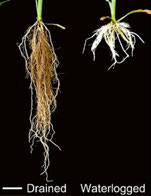Hydroponic Rootboxes to Study Waterlogged Plants and Soil

Hydroponic Rootboxes, to study root growth of (wetland) plants (as related to soil properties) under waterlogged / flooded conditions (see Figure). We developed a robust, low-cost, floodable rootbox design that allow root imaging and subsequent access to roots and soil via removable (transparent) front and/or rear panels. The tightly sealed, experimental hydroponic culture system was designed to effectively prevent leakage (double seal). A drainage system (with side outlets in the U-frame) can be fitted as an option for convenient water level adjustment.
Hydroponic RootBox - Features
- Investigate roots, rhizosphere, soil under flooded / waterlogged conditions
- Standard (5 cm inner diameter) and custom sizes (X x Y x Z) - small to large
- Durable, monolithic U-profile, with inserts to reduce bolthole wear; 6 mm PMMA front and rear panels
- Leakproof, double sealing (replaceable)
- Future-proof, with spare parts and exact replicas (for expanding experimental setups, etc.) available for years to come
Optional
- Wide range of custom accessories: Racks (vertical or angled), shading panels, etc.
- Drainage system, to set water levels at different heights
- Matching respiration chambers, for integrated gas flux measurements (CO2, methane etc.)
Contact us to discuss standard / custom sizes and rootbox accessories for your flooded root and soil experiment.
Water Logging Effects on Roots & Soil

The term waterlogging is used to describe the (super)saturation of the soil beyond the field capacity. Except in natural wetlands, waterlogging occurs when the infiltration of water from rainfall or flooding exceeds the rate of drainage and evapotranspiration. Diffusion of gases, particularly O2, is ∼10k-times slower in water than in air, leading to rapid O2 depletion in waterlogged soils - as diffusion fails to keep pace with the respiratory demand of roots and microbes. Oxygen depletion in the root zone therefore has a direct and rapid effect on plant growth by limiting aerobic respiration.
- Many species that are well adapted to waterlogging, such as rice, alder or Cyperaceae species, have aerenchyma formed in root tissues that allow for the transport of oxygen within the root. Show more
-
Others, such as mangroves, tap oxygen above the water table by developing special organs. These root morphological, anatomical and/or physiological adaptations can (at least partially) compensate for O2 deficiency in the soil and support aerobic root respiration. Much work has therefore focused on the development and functional role of aerenchymatous roots under waterlogged conditions. On the other hand, the quantification of responses of 'normal' (lateral) roots to waterlogging in 'non-wetland' plants/crops has often been overlooked. This is surprising given that extremes in water availability (both wet and dry) will increase worldwide under future climate conditions, and that many management practices (e.g. heavy machinery for harvesting) increase soil compaction - compaction makes soils more susceptible to waterlogging by reducing pore space. In addition to the direct effects of O2 depletion, many other soil biochemical processes are affected by waterlogging, including major changes in nutrient availability. It is therefore crucial that root and soil processes under temporary waterlogging receive more attention from researchers worldwide. Vienna Scientific aims to provide the technical means - through the development of effective hydroponic rootbox systems - that will enable the easier set-up of studies on the topic.
| References |
Roots and Rhizosphere under Flooded Conditions |
OPEN |
|
||
Racks & Light Shielding Panels are made to hold the hydroponic RootBoxes safely and to keep light off the roots.
For standard root system experimentation ex situ, the free draining Rhizoboxes are the experimental platform of choice.







